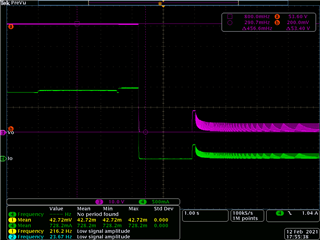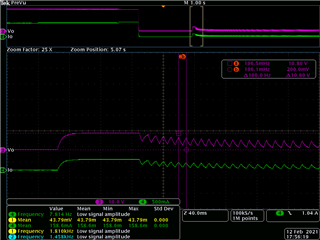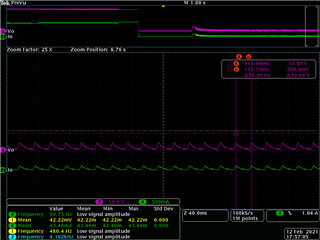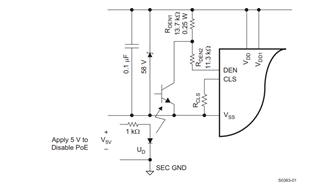Other Parts Discussed in Thread: , TPS2373
Hello,
I was performing over-current tests on the TPS2372, using both the TPS2372-4EVM-006 Eval board and a board I designed myself with the TPS2372 was the PD PoE controller.
When TPS2372 is configured for Type 4 PoE and I pull more than 70W with a 300+ foot Ethernet cable (or 90W with a 1-foot cable, equivalent to 70W with a 300ft cable), instead of the TPS2372 protecting itself and opening up the internal MOSFET to stop current consumptions, it seems the TPS2372 is trying to regulate the PoE output voltage/current even beyond these power consumptions (see oscilloscope screenshots below). During a PoE over-current event, the TPS2372 gets very hot (~130C) very quickly. Instead of the TPS2372 completely shutting down the current flow, the PoE output voltage and current oscillates at 50Hz~100Hz causing the rapid 130C self-heating. I did not leave it in this state long enough to damage the TPS3272 part, but I assume it would eventual be damaged if I did leave.
By the way, the same thing happens if the TPS2372 is configured for Type 1 PoE, and I try to draw 30W. Same over-current event happens, and the voltage and current oscillations occur resulting in the same self-heating up to 130C. Please help!
My setup includes a PoE injector connected to the TPS2372-4EVM-006 Eval board (also tried with my own board with same results), and a resistor load box connected to the VDD/RTN output power lines. I tried to pull up to and beyond 90W. I was anticipating that the TPS2372 would protect itself and shut off the power if tried to pull to much power, but it instead the voltage and current



Thanks,
Nick Smith


